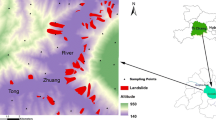Abstract
Landslide hazard is as the probability of occurrence of a potentially damaging landslide phenomenon within specified period of time and within a given area. The susceptibility map provides the relative spatial probability of landslides occurrence. A study is presented of the application of GIS and artificial neural network model to landslide susceptibility mapping, with particular reference to landslides on natural terrain in this paper. The method has been applied to Lantau Island, the largest outlying island within the territory of Hong Kong. A three-level neural network model was constructed and trained by the back-propagate algorithm in the geographical database of the study area. The data in the database includes digital elevation modal and its derivatives, landslides distribution and their attributes, superficial geological maps, vegetation cover, the raingauges distribution and their 14 years 5-minute observation. Based on field inspection and analysis of correlation between terrain variables and landslides frequency, lithology, vegetation cover, slope gradient, slope aspect, slope curvature, elevation, the characteristic value, the rainstorms corresponding to the landslide, and distance to drainage Une are considered to be related to landslide susceptibility in this study. The artificial neural network is then coupled with the ArcView3.2 GIS software to produce the landslide susceptibility map, which classifies the susceptibility into three levels: low, moderate, and high. The results from this study indicate that GIS coupled with artificial neural network model is a flexible and powerful approach to identify the spatial probability of hazards.
Similar content being viewed by others
References
Carrara A, Cardinali M, Detti Ret al. GIS techniques and statistical models in evaluating landslide hazard,Earth Surface Processes and Landforms, 1991,16: 427–445.
Varnes D J. Landslide Hazard Zonation: a Review of principles and practice. Commission on landslides and other mass-movements IAEG, UNESCO, Pairs, Natural Hazards No.3, 1984, 61pp.
Dai. FC, C F Lee, V S S Lamet al. GIS-based landslide susceptibility mapping: a case study. Proceedings of the symposium on slope hazards and their prevention, Hong Kong, 2000. 258–263.
Niemann K O, Howes D E. Applicability of digital terrain models for slope stability assessment.FTC Journal, 1991, (3): 127–137.
Atkinson P M, Massari R. Generalized linear modeling of landslide susceptibility in the Central Apennines, Italy.Computers & Geosciences, 1998,24 (4): 373–385.
Yin K L, Yan T Z. Statistical predication models for slope instability of metamorphosed rocks. In: Proceedings of the 5th International Symposium on Landslides. ed. C Bonnard, Lausanne, Switzerland, Vol.2, 1988, v 1269–1272.
Bemknopf R L, Campbell R H, Brookshire D Set al. A probabilistic approach to landslide hazard mapping in Cincinnati, Ohio, with applications for economic evaluation.Bulletin of the Association of Engineering Geologists, 1988,25 (1): 39–56.
Gupta R P, Joshi BC. Landslide hazard zoning using the GIS approach—a case study from the Ramganga catchment, Himalayas.Engineering Geology, 1989,28: 119–131.
Siddle H J, Jones D B, Payne H R. Development of a methodology for landslip potential mapping in the Rhondda Valley. In: Slope Stability Engineering. Ed. RJ Chandler, London: Thomas Telford. 1991. 137–142.
Wang SQ, Unwin D J. Modelling landslide distribution on loess soils in China: an investigation.Int. J. Geographical Information System, 1992,6 (5): 391–405.
Naranjo J L, Van Western C J, Soeters R. Evaluating the use of training areas in bivariate statistical landslide hazard analysis: a case study in Colombia.FTC Journal, 1994, (3): 292–300.
Zhou C H, Li J, Xu Z W. Landsldes Analysis within GIS, Keynote paper, Symposium on slope hazards and their prevention, 2000. 17–28.
Fernandez C I, Castillo T F D, Handouni R Eet al. Verification of landslide susceptibility mapping: a case study.Earth Surface Processes and Landforms, 1999, (24): 537–544.
Van Western C J, Rengers N, Terlien M T Jet al. Predication of the occurrence of slope instability phenomena through GIS-based hazard zonation, Geol Rundsh 86, 1997, 404–414, Springer-Verlag.
Mark N. Frenchet al. Rainfall forecasting in space and time using a neural network.Journal of Hydrology, 1992,137: 1–31.
Geotechnical Control Office (GCO). Geotechnical Area Studies Programme-North Lantau. GASP VI, Hong Kong Government, 1988a.
Geotechnical Control Office (GCO). Geotechnical Area Studies Programme-South Lantau, GASP XI, Hong Kong Government, 1988b.
Wong H N, Chen Y M and Lam K C. Factual report on the November 1993 natural terrain landslides in three study areas on Lantau Island (3 volumes), Special Projects Report, GEO, Hong Kong, 1996.
Wong H N, Lam K C and Ho K K S, Diagnostic report on the November 1993 Natural Terrain Landslides on Lantau Island, GEO Report No.69, Hong Kong, 1998.
Dai F C, Lee CF, Wang S J. Analysis of rainstorm-induced slide-debris flows on natural terrain of Lantau Island, Hong Kong.Engineering Geology, 1999,51: 279–290.
Giles M. Foody. Land cover classification by an artificial neural network with ancillary information.International Journal of GIS, 1995,9(5): 527–542.
Mark R K, Ellen S D. Statistical and simulation models for mapping debris flow hazard. In: Carrara, A.& F. Guzzetti (eds), Geographical Information Systems in assessing natural hazards. The Netherlands: Kluwer Academic Publishers, 1995. 93–106.
Sharma S. Applied multivariate techniques. John Wiley & Sons, 1996.
Author information
Authors and Affiliations
Corresponding author
Rights and permissions
About this article
Cite this article
Zeng-wang, X. GIS and ANN model for landslide susceptibility mapping. J. Geogr. Sci. 11, 374–381 (2001). https://doi.org/10.1007/BF02892323
Received:
Accepted:
Issue Date:
DOI: https://doi.org/10.1007/BF02892323




